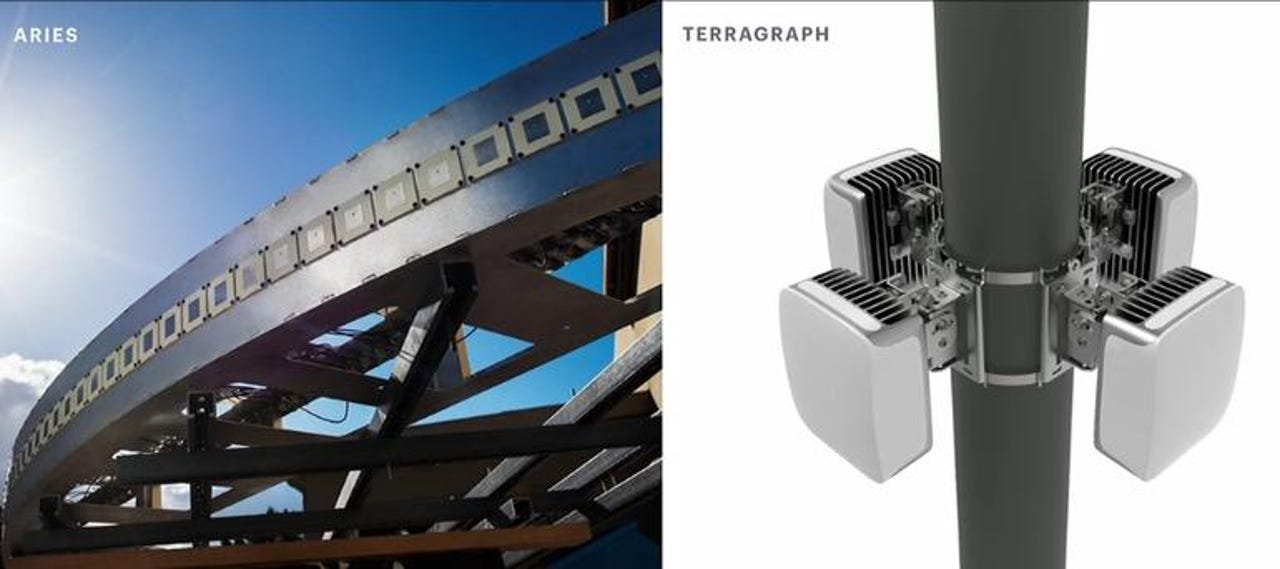Facebook's connectivity plans take shape through Aries, Terragraph projects


Among his many ambitious plans for the next 10 years, Facebook CEO Mark Zuckerberg really wants to connect every person on the planet to the internet.
According to Facebook, fewer than half of the world's population is online, and 1.6 billion people do not live within range of a data network. These figures are part of the driving force behind the social network's years-long focus on spreading connectivity access across the globe.
F8 2019
During the F8 keynote Wednesday, Facebook head of infrastructure and VP of engineering Jay Parikh detailed two new technology systems that are designed to better tackle the world's internet shortfall and bring access to underserved areas.
The first system is called Terragraph and it aims to push broadband through dense cities and urban areas where networks are frequently jammed with traffic.
Terragraph places 60GHz network nodes throughout a city, on things like lamp posts or the sides of buildings. The signal can stretch up to 820 feet between nodes and in doing so, it can add broadband to areas where cost and infrastructure hurdles can make fiber lines or other high-speed internet impossible.
Simply put, Terragraph could replace fiber in congested urban areas for faster internet.
The second system is named Project Aries and it's meant to increase the bandwidth of towers. Aries stands for Antenna Radio Integration for Efficiency in Spectrum, and unlike Terragraph, its focus is on covering larger areas.
Aries uses 96 antennas (as opposed to 1) and can support up to 24 devices simultaneously. Facebook says the Aries prototype shows spectral and energy efficiency gains around 10x over traditional 4G systems.
In a nutshell, Aries will aim to improve mobile signal strength in rural communities by using the existing wireless spectrum in a more efficient way.
Facebook plans to make both technologies available to wireless communications researchers via the Telecom Infra Project, the connectivity-focused cousin of the Open Compute Project.
Both Terragraph and Aries take a terrestrial approach to spreading internet connectivity, as opposed to Facebook's giant boomerang-like UAV dubbed Aquila. The solar powered plane is designed to beam internet access to earth from up in the sky.
The aircraft received a fair amount of spotlight during F8, from virtual reality demos to details on how Facebook built the device to make it capable of flying around for months at a time.
In a way, Facebook is making a point by showing that these types of connectivity projects are doable.
Outside of connectivity, Facebook CTO Mike Schroepfer gave a live on-stage demo showing some early stage apps built by the Facebook Social VR team. The goal was to highlight the potential of VR for social interaction, although most of the brouhaha came about when Schroepfer met up with a fellow Facebook employee Michael Booth via VR and snapped a selfie.
Another notable announcement out of Wednesday's keynote was news that Facebook's React Native was getting backed by Samsung and Microsoft. React Native is a framework for building single-page apps.
Facebook's Christine Abernathy revealed that Samsung was building React Native for Tizen, meaning that React Native developers will soon be able to build apps that run on Samsung Smart TVs.
Microsoft is bring React into the Windows 10 ecosystem, which will allow developers to build apps that run on Windows PCs, Xbox, and Windows Phone.